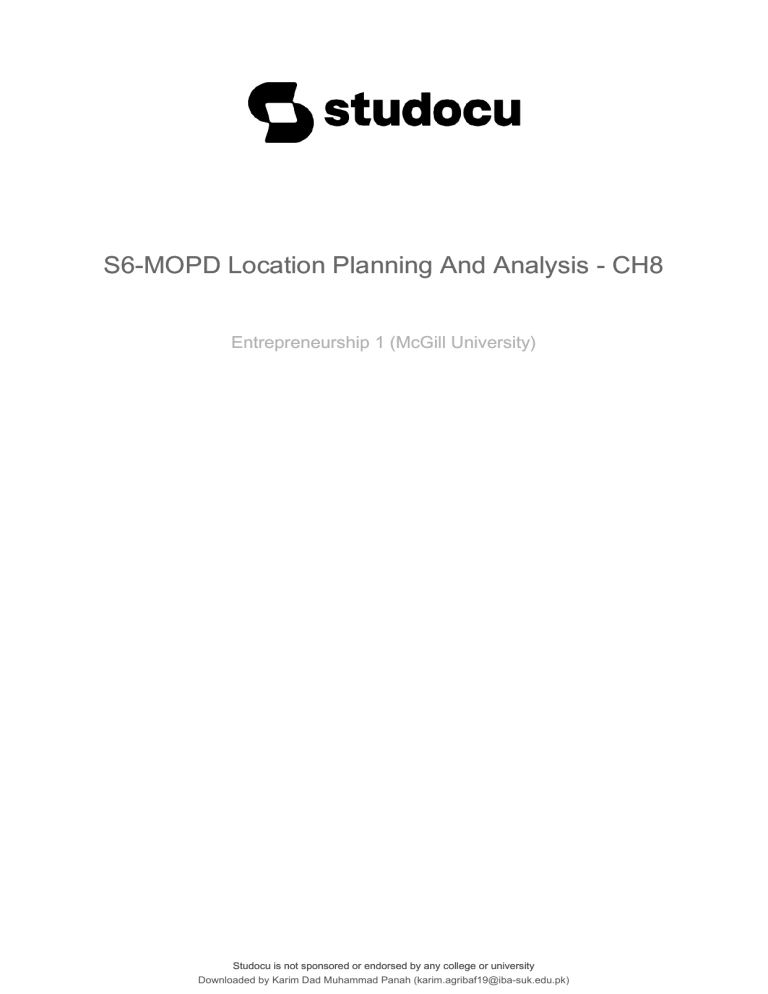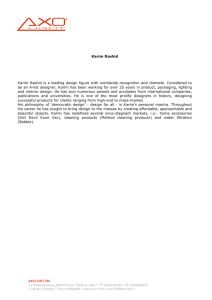
lOMoARcPSD|21525583 S6-MOPD Location Planning And Analysis - CH8 Entrepreneurship 1 (McGill University) Studocu is not sponsored or endorsed by any college or university Downloaded by Karim Dad Muhammad Panah (karim.agribaf19@iba-suk.edu.pk) lOMoARcPSD|21525583 Zoe Zwiebelmann Maastricht University S6-MOPD LocationPlanning MOPD-S6: Location Planning and Analysis – CH8 1. THE NEED FOR LOCATION DECISIONS • market expansion: addition of location to existing system (fast-food chains, supermarkets) • growth in demand: expansion at existing location not sufficient • relocate due to exhaustion of resources • shift in markets: costs of doing business at certain location becomes to expansive à move 2. THE NATURE OF LOCATION DECISIONS 2.1 STRATEGIC IMPORTANCE OF LOCATION DECISIONS • closely tied to organisation’s strategies: eg low-cost producer locates where labour costs low • impact on capacity & flexibility: locations possibly subject to space constraints, local restrictions • strategically important: entail long-term commitment; have impact on investment requirements, operating costs, revenues, operations, supply chains in general 2.2 OBJECTIVES OF LOCATION DECISIONS • finding a number of acceptable locations; rather than the one best location • location in supply chain as criteria: 1) at end of chain: focus on accessibility, demographics, traffic patterns, local customs (close to customers) 2) at begin of chain: located near source of raw materials 3) at middle of chain: near suppliers or near markets (depends) 2.3 SUPPLY CHAIN CONSIDEREATIONS • supply chain configuration: determining number and location of suppliers, production facilities, warehouses, distribution centres • centralised/decentralised distribution: (a) centralised: yields scale economies as well as tighter control (b) more responsive to local needs, possibly lower transportation costs 2.4 FOUR LOCATION OPTIONS 1) expand existing facility: attractive if room for expansion + if location has desirable features; often less costly than other options 2) add new locations while retaining existing ones: defensive strategy to maintain market share or prevent competitors from entering market 3) shut down at one location and move to another: reasons – shift in markets, exhaustion of raw materials, cost of operations 4) do nothing: analysis of potential locations fails to uncover benefits 3. GLOBAL LOCATIONS 3.1 FACILITATING FACTORS 1) trade agreements: barriers to international trade such as tariffs and quotas have been reduced or eliminated with trade agreements such as NAFTA and GATT Downloaded by Karim Dad Muhammad Panah (karim.agribaf19@iba-suk.edu.pk) lOMoARcPSD|21525583 Zoe Zwiebelmann Maastricht University S6-MOPD LocationPlanning 2) technology: technological advances in communication and information sharing have been helpful in facilitating international locations 3.2 BENEFITS • not all benefits apply to every situation 1) markets: expanding; better serving customers by being more attuned to local needs & having quicker response time when problems occur 2) cost savings: transportation costs, labour costs, raw material costs, and taxes 3) legal and regulatory: more favourable liability and labour laws, less restrictive environmental and other regulations 4) financial: avoid impact of currency changes; incentives offered by governments to attract business 5) other: new sources of ideas for products, new perspectives on operation and solutions to problems 3.3 DISADVANTAGES 1) transportation costs: poor infrastructure; great distances à can offset savings in labour/material 2) security costs: increased security risks and theft 3) unskilled labour: negative impact on quality and productivity; may increase training costs 4) import restrictions: possible solution – local suppliers 5) criticisms: unfair practices in form of sweatshops; operating in countries with fewer environmental regulations 3.4 RISKS 1) political: instability and unrest; governments may try to nationalise facilities 2) terrorism: decreases unwillingness of domestic personnel to travel/work in certain areas 3) economic: possible inflation or deflation 4) legal: laws and regulations may change à reducing or eliminating benefits 5) ethical: corruption and bribery 6) cultural differences 3.5 MANAGING GLOBAL OPERATIONS - DIFFICULTIES • language and cultural differences: increased risk of miscommunication; interference with developing trust; difference in management styles • increasing distances and travel times: decreased tendency for face-to-face meetings • coordination of far-flung operations more difficult: difference in level of technology • domestic personnel may resist relocating 4. GENERAL PROCEDURE FOR MAKING LOCATION DECISIONS • location decisions often depend on size and nature or scope of operations • new/small firms: adopt rather informal approach to location decisions à close to where owner lives • large/established firms: adopt rather formal approach to location decisions à consider wide range of geographic locations Downloaded by Karim Dad Muhammad Panah (karim.agribaf19@iba-suk.edu.pk) lOMoARcPSD|21525583 Zoe Zwiebelmann Maastricht University S6-MOPD LocationPlanning LOCATION DECISION PROCESS 1. decide on criteria for evaluating location alternatives (eg increased revenues/community service) à matter of managerial preference 2. identify most important factors (eg location of markets or raw materials) 3. develop location alternatives: identify – (a) country/countries for locations (b) general region for location (c) small number of community alternatives (d) site alternatives among community alternat. 4. evaluate alternatives and make selection 5. IDENTIFYING A COUNTRY, REGION, COMMUNITY AND SITE • some dominating factor for decision: (a) manufacturing – availability of abundant energy and water supply + proximity to raw materials (b) service orgas – traffic patterns, convenience, competitors’ locations, proximity to market • human factors can be relevant as well (eg culture shock) à once orga has determined most important factors, it will narrow to suitable alternatives to one region, then small number of community site alternative identified and analysed 5.1 IDENTIFYIG A COUNTRY • each country has own set of potential benefits and risks • factors: government (policies, restritions etc); cultural differences; customer preferences; labour, resources; financial; technological; market; safety 5.2 IDENTIFYING A REGION • primary regional factors: raw materials, markets, labour conditions LOCATION OF RAW MATERIALS • necessity: mining operations, forestry, fishing • perishability: freezing fresh fruit and vegetables, processing of dairy, bakery • transportation costs: in industries where processing eliminates much of bulk connected with raw material à paper production, cheese making; inputs from different locations – firms choose geographical center as location • others: vendors near most important customers; new locations near existing retail outlets LOCATION OF MARKETS • competitive pressures: (a) market served by particular location too small for more than one competitor (b) opposite – desirable to locate near competitors (attracts large number of shoppers) • perishability • distribution costs: firms that require close customer contact (eg home repair services) • government services: police patrols concentrated in high crime areas, hospitals in central locations Geographic information system (GIS): computer-based tool for collecting, storing, retrieving, displaying demographic data on maps; aids decision makers in targeting market segments, identifying locations relative to market potential, planning distribution networks LABOUR FACTORS 1) cost and availability 2) wage rates in area 3) labour productivity & attitudes towards work 4) unions OTHER FACTORS 1) climate 2) taxes Downloaded by Karim Dad Muhammad Panah (karim.agribaf19@iba-suk.edu.pk) lOMoARcPSD|21525583 Zoe Zwiebelmann Maastricht University S6-MOPD LocationPlanning 5.3 IDENTIFYING A COMMUNITY • attitude toward business in community: 1) pro - attract new businesses bc of jobs and tax revenues 2) do not businesses to pollute or lessen quality of life • factors determining desirability of community: facilities for education, shopping, recreation, transportation, entertainment; quality of police, medical service; size of community • trends: 1) just-in-time manufacturing (encourages suppliers to locate near customers to reduce lead time) 2) microfactory (small factory with narrow product focus, located near major markets) 3) advances in IT (improves connection and information à may reduce need for location together) 5.4 IDENTIFYING A SITE • primary considerations: land, transportation, zoning/restrictions • long-term commitment considerations: requirement of room for future expansion, current utility and sewer capacities, sufficient parking space, access roads for trucks (land costs rather secondary) • worthy alternative: industrial parks à + land is already developed – limits kinds of activities that firm can conduct, especially for future development • size and proximity of airport/train station: important for traveling employees 5.5 MULTIPLE PLANT MANUFACTURING STRATEGIES Product Plant Strategy = entire products or product lines are produced in separate plants, each plant supplies entire domestic market à decentralised approach + specialisation that results in economies of scale = lower costs Market Area Plant Strategy = plants serve particular geographic segment with all available products à centralised approach + savings on shipping; rapid delivery & response to local needs - higher operating costs Process Plant Strategy = different plants concentrate on different aspects of process; best suited for products with multiple components à centralised approach + less confusion; highly specialised = economies of scale - additional shipping costs General-Purpose Plant = plants handle wide range of products + quick response to product/market changes Strategy - less productive & higher operating costs • general benefit of multiple plant: learning opportunities due to knowledge-sharing between plants 6. SERVICE AND RETAIL LOCATIONS • not cost-focused, but revenue-focused • concerned with demographics: age, education, population area, competition, traffic volume • seek locations with population densities: near/in center of markets they serve • unique business: nearness to competitor not a factor/maybe not even desirable • general retail business: nearness to competitors desirable due to concentration of customers Downloaded by Karim Dad Muhammad Panah (karim.agribaf19@iba-suk.edu.pk) lOMoARcPSD|21525583 Zoe Zwiebelmann Maastricht University S6-MOPD LocationPlanning 7. EVALUATING LOCATION ALTERNATIVES – pp. 385-390 old book 7.1 LOCATIONAL COST-PROFIT-VOLUME ANALYSIS Locational cost-profit-volume analysis: can be evaluating choices in economic terms Procedure 1. determine fixed & variable costs associated with each alternative 2. plot total-cost/total-profit lines for all alternatives on same graph 3. determine which location has lowest cost/highest profit for expected output 4. determine ranges of output on different which alternatives are best Total cost = FC + v * Q Total profit = Q*(R-v) – FC done numerically or graphically; technique for Assumptions 1. fixed costs constant for range of output 2. variable costs linear for range of output 3. required level of output can be closely estimated 4. only one product involved (R=revenue per unit) 7.2 TRANSPORTATION MODEL Transportation model: includes transportation costs in locational cost-volume analysis by incorporating the transportation cost per unit being shipped into the variable cost per unit • transportation model of linear programming: special-purpose algorithm used to determine minimum transportation cost that would result if potential new locations were added to system 7.3 FACTOR RATING Factor rating: general approach to evaluating locations that includes quantitative and qualitative inputs; enables decision makers to incorporate personal opinions in decision process Procedure 1. determine which factors are relevant (eg location of market, water supply etc) 2. assign weight to each factor that indicates relative importance (sums up to 1) 3. decide on common scale for all factors (eg 0-100) 4. score on each location alternative 5. multiply factor weight by score for each factor à then sum scores for each alternative 6. choose alternative that has highest composite score (possibly even set min threshold) Alternative 2 preferred! Downloaded by Karim Dad Muhammad Panah (karim.agribaf19@iba-suk.edu.pk) lOMoARcPSD|21525583 Zoe Zwiebelmann Maastricht University S6-MOPD LocationPlanning 7.4 CENTER OF GRAVITY METHOD Center of gravity method: method for locating a distribution center that minimises distribution costs; often also used for locating public centres to minimise travel time to answer emergencies • distribution cost as linear function of distance and quantity shipped • quantity shipped mostly fixed, but some variations (seasonal) are possible Center of gravity: location of distribution center; average of x coordinates and y coordinates QUANTITIES SAME FOR ALL DESINATIONS 1. add all coordinates for x (y) 2. divide by all destinations à get overall coordinate QUANTITIES DIFFERENT FOR DESTINATIONS Downloaded by Karim Dad Muhammad Panah (karim.agribaf19@iba-suk.edu.pk)






